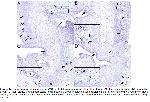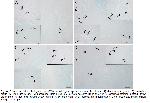Research and Publication Ethics: This study received approval from the Fırat University Experimental Animals Research Ethics Committee on January 31, 2018, under the approval number 19.
Animals: The study involved 40 adult female Sprague Dawley rats, aged 23 months and weighing 200-250 grams, obtained from Fırat University's Experimental Animals Unit. The animals were housed in standard laboratory conditions, observing a 12-hour light/dark cycle (lights switched on at 7:00 AM), maintaining a temperature of approximately 21 ± 1°C, and sustaining a relative humidity between 50-60% with food and water available ad libitum. The study strictly adhered to all applicable national and international regulations and guidelines concerning the care and use of laboratory animals.
Experimental Design: All animals were uniformly and randomly allocated into four distinct groups; sham vehicle, paroxetine, irisin, and paroxetine+irisin. These groups are detailed as follows:
Sham Vehicle group (n=10): Animals in this group were given 0.2 mL of deionized water daily via oral gavage during an eight-week experimental period. In addition, these rats continued to receive deionized water subcutaneously via mini-osmotic pumps starting from the end of the 4th week until the end of the experiment.
Paroxetine group (n=10): Throughout an eight-week experimental period, these rats were administered a daily dosage of paroxetine, dissolved in deionized water at a concentration of 20 mg/kg/day, via oral gavage.
Irisin group (n=10): Rats in this group were administered irisin at a dose of 100 ng/kg/day for the last four weeks of the experimental period of the eight-week, utilizing mini-osmotic pumps.
Paroxetine+Irisin group (n=10): Rats in this group were administered paroxetine at a dosage of 20 mg/kg/day via oral gavage for eight weeks. Following the first four weeks of eight weeks of paroxetine treatment, they were additionally administered irisin at a dose of 100 ng/kg/day for four weeks, delivered through mini-osmotic pumps.
Paroxetine Treatment: Every day for about eight weeks, female rats in the paroxetine and paroxetine+irisin groups received a dose of 20 mg/kg of paroxetine. The dosage was administered between 10:00 and 12:00 via oral gavage 22. Paroxetine hydrochloride (SmithKline Beecham Pharmaceuticals, UK) was dissolved in 0.2 mL of deionized water and freshly prepared for each rat daily. This daily regimen of paroxetine was maintained for the duration of the experiment.
Implantation of a Mini-osmotic Pump and İrisin Treatment: After four weeks of treatment with either paroxetine or deionized water, animals from the sham vehicle, irisin, and paroxetine+irisin groups were anesthetized using an intramuscular administration of ketamine (60 mg/kg) and xylazine (5 mg/kg) in preparation for pump insertion. The interscapular area was shaved and sterilized with a solution of 70% alcohol and povidoneiodine to make it ready for implantation. Subsequently, a subcutaneous pocket was created using a blunt dissection. Then, ALZET mini-osmotic pumps (with a delivery rate of 0.25 μL/h, model 2004; DURECT Co., Cupertino, CA, USA) were inserted. These pumps contained either deionized water (for the sham vehicle group; n=10) or irisin (100 ng/kg of body weight per day) 23 dissolved in deionized water (for the irisin and paroxetine+irisin groups; n=10 each). These pumps were designed to continuously infuse their contents subcutaneously over about a four-week period. The incision site was sewn closed using sterile sutures and was monitored on a daily basis until the wound healed completely.
Termination of Experiments: Upon completing about a four-week irisin administration period, all animals within each group were euthanized via decapitation using a guillotine during the diestrus phase. Following this, their blood was collected in pre-cooled EDTA-2Na tubes. The blood samples were then centrifuged at 4000 rpm for a duration of 5 minutes at a temperature of +4°C to provide the serum. Prior to being evaluated by Enzyme-Linked Immunosorbent Assay (ELISA), the serum samples were stored at a temperature of -20 °C.
ELISA: Serum levels of 17β-estradiol and progesterone were quantified using ELISA kits from Enzo Life Sciences (ADI-900-008 and ADI-900-011, respectively, Enzo Life Sciences, Switzerland) following the manufacturers instructions. The optical density was measured at 405 nm with a plate reader (Multiskan FC, Thermo Fisher Scientific, Waltham, Massachusetts, USA). Assay sensitivity was 28.5 pg/mL and 8.57 pg/mL, and the assay range was between the values of 29.3-30000 pg/mL and 15.62-500 pg/mL for 17β-estradiol and progesterone ELISAs, respectively.
Histological Procedures: In the histological examination process, samples of uterine tissue were procured. These were then fixed in a 10% formalin solution for a period of 12 hours. To eliminate formaldehyde effectively, the fixed samples were kept in a water bath for a total of 24 hours. The samples were then dehydrated using a series of graded alcohols and xylol. Lastly, the tissues were embedded into paraffin blocks, preparing them for subsequent analysis.
Histochemical Staining
Toluidine blue staining: To illustrate the distribution and enumerate the metachromatic MCs, 10 consecutive 5 μm cross-sections taken at 30 μm intervals from the prepared blocks were treated with a staining procedure. A 0.5% TB, which was adjusted to a pH of 0.5 and prepared in McIlvaine's citric acid disodium phosphate buffer, was used as the staining agent. The staining process was carried out over a period of 10 minutes 10.
Combined alcian blue-safranin O (AB/SO) staining: To categorize the MCs subtypes, slices were extracted from each block. These sections, measuring 5 μm in thickness and spaced at 30 μm intervals, were placed on the same slide. They were then treated with a combined dye solution comprised of AB (0.5%, pH 0.2) and SO (0.25%, pH 1.42), prepared in a 0.2 M acetate solution 10.
Histochemical analysis and quantification of MCs: Upon completion of the histochemical staining process, the preparations were analyzed under an examination microscope (Nikon Eclipse 50i) to discern their staining properties. The distribution of cells exhibiting metachromatic staining with TB, AB, and SO was evaluated. For the purpose of determining the numerical distribution of TB (+), AB (+), and SO (+) MCs, counts were carried out utilizing a 100-square ocular micrometer (eyepiece graticule), on the serial sections prepared. MCs were enumerated in 100-square-units of the ocular micrometer, under a magnification of X40. Cell counts were performed across 10 randomly selected areas within the sections, and the arithmetic mean was calculated. Subsequently, all the numerical data were recalculated to express the count of MCs per square millimeter (mm2) area.
Statistical Analyses: Data were provided as a mean±the standard error of the mean (S.E.M). The Shapiro-Wilk test was used to confirm whether the data was normally distributed. Once normality was ascertained, a one-way ANOVA test was performed, followed by Tukey's post hoc test for multiple comparisons, to evaluate the data. Data interpretation was carried out using SPSS 21.0 (SPSS Inc, Chicago, IL). A p-value less than 0.05 was considered statistically significant.






